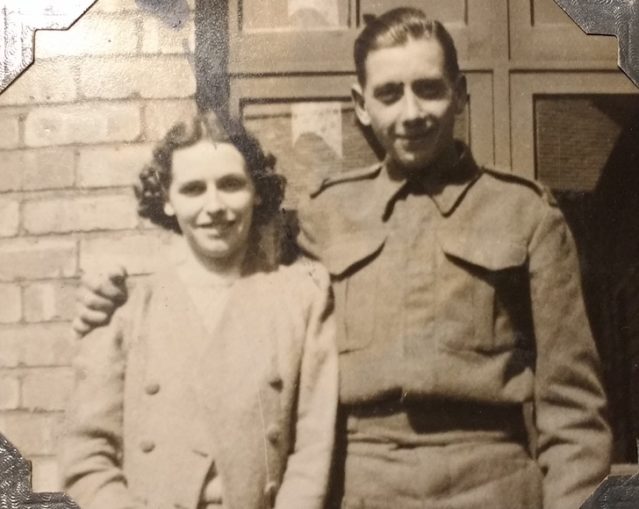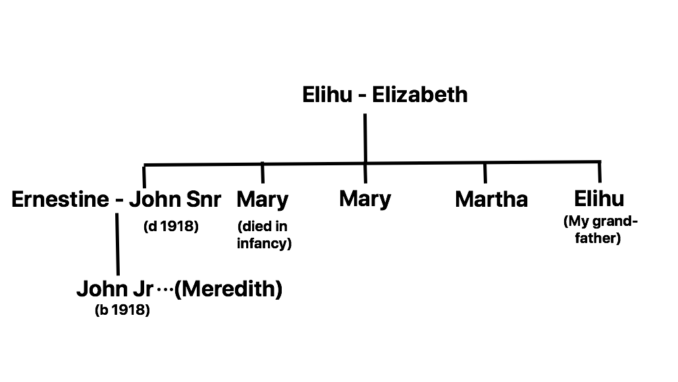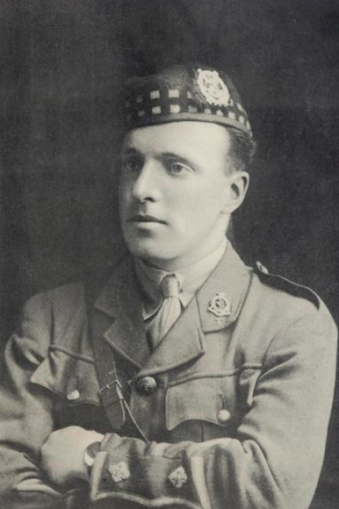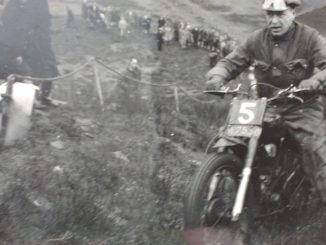
© Always Worth Saying 2022, Going Postal
With there being only 11 years between them both my grandfather, Elihu, and his nephew, John Jr, joined up for the Second War. Last time we looked at my grandfather’s service in the RAOC and Home Guard. Before we move on to John Jr and his sweetheart Meredith, pictured above (who has her own interesting story to tell), sterling work by Puffin Captain Slugwash sheds more light upon the death of John Jr’s father, John Snr, during WW1.
Having joined the 10 Bn Liverpool Kings (Scottish) Regiment, one of the better territorial forces, John Snr had been early to France as one of the original ‘Maidanmen’ dispatched via the SS Maidan on 1st November 1914.
Married to Ernestine during leave on 7th May 1916, November of the same year saw him in Belgium in the lul before a daring raid on enemy lines.
From Captain Slugwash’s retrieved documents we can piece together the events of late 1916. The story begins on 3rd October, only 5 months after the John and Ernestine’s Liverpool wedding, with the battalion sent back to Ypres, to frontline trenches at Weiltje, by co-incidence relieving a regular army battalion from the Border Regiment many of whom will have been recruited from John’s native Carlisle.
Amongst the monotonous grind of trench duty between mayor offences, 10th Bn Liverpool Scottish officers had cause for a celebratory luncheon on 28th October, more of which later.
Within days of the celebration, 166th Brigade HQ selected the 10th to carry out an attack on an intrusive German salient known as Kaiser Bill. Volunteers were called for. Harold Giblin in Bravest of Hearts records that all places were filled with ‘very little arm twisting.’ One of the volunteers was the aforementioned John Snr, my great uncle.

© Always Worth Saying 2022, Going Postal
Entrained at Ypres for Brandhoek, the volunteers arrived at Camp C for intensive training in anticipation of the raid. Machine-gun fire and cooking smoke emerging from Kaiser Bill in abundance suggested the presence of a large garrison.
The object of the raid was to kill or capture the enemy, determine the regiment present and destroy dugouts, machine-gun and trench mortar emplacements.
Arial photography allowed for a full-sized replica of the salient to be marked out, a safe distance from the front, to be used to develop a plan. As a result, the raiding party was split into smaller sections each with a specific task which was practised over and over again both during day and night.
The sections were organised into two, a left raiding party and a right raiding party. Each consisted of the required mix of scouts, torpedo and wire cutters, bombers, ditch blockers, throwers, bayonetters, spare men et al.
Altogether there were 3 officers, 75 other ranks, two Royal Engineer Non-Commissioned Officers and 6 RE sappers.
Those spare men were to be needed as an incident occurred during training which necessitated a Court of Enquiry. Captian Dickinson and Lieutenants Makant and Alder took evidence from witnesses and visited a bombing pit where the incident had happened.
On 22nd November, some of the raiding party had been taken to practice throwing live bombs. The pit used consisted of two protective bays of six-foot-high sandbags, a right one for officers, NCOs and the thrower, and a left one for the rest of the party.
When the pin from a bomb was drawn, a whistle was blown allowing all men to take cover. The bombs were fused, with the hissing of the fuse being audible while thrown out of the bay with the bomb not exploding until it had travelled a safe distance.
Before use, bombs were examined for faults. One was set aside because of a perforation between its detonator well and striker well.
Each of the men threw five bombs during the afternoon. As well as the faulty one, four others proved to be duds and did not explode.
When Lance Corporal Donnelly took his turn, his first bomb went off as expected but only the detonator exploded on his second. On this third throw, the bomb detonated almost immediately upon the release of the pin, only a foot above the pit’s parapet. A Corporal George was killed and 13 others were injured.
As part of his witness statement, Acting Medical Officer Captian J E Rusby submitted a list of casualties and their wounds. Thrower Donelly had injuries to his fingers, right hand and left knee. My great uncle’s injuries were described as GSW to the chest and head. GSW generally refers to ‘Gun Shot Wounds’. In this instance, we shall assume it to mean gunshot type wounds or possibly grenade shell wounds. All but one of the injured, including my great uncle, were admitted to hospital.
The court concluded that the accident had been caused by a premature bursting of a faulty bomb. A fault even careful examination would have failed to detect. No officer or NCO was to blame. All the men had been told what precautions to take and appeared to have done so.

Group portrait of The Liverpool Scottish,
Robert Andrew Scott Macfie – Public domain
The battalion’s war diary soberly records the actual raid. The cultured and restrained hand of the commanding officer, Lieutenant Colonel FMW Drew DSO, recalled events of the 29th November 1916. Field and heavy artillery bombarded Kaiser Bill salient for about 20 minutes with the left and right raiding parties beginning their advance at 4:50 pm. They entered the German trenches and carried out the previously arranged programme with great success. Much useful information and identifications were obtained. Eight prisoners were brought back. The next day the raiding party had been congratulated by the Divisional General. Drew continues,
“Our casualties by the enemy artillery were fairly heavy. The day of the 30th was spent doing fatigue duty, all available men being employed.”
Total casualties for the month were 3 officers wounded (2 accidentally), 5 of ranks killed (1 accidentally), 36 of ranks wounded (11 accidentally). The discrepancy between the bomb practice casualties and battalion casualties can be understood as injured Royal Engineers.
Giblin notes that the kilted ‘Die Frauen Aus Hullen’ – The Ladies From Hell – suffered one death and one missing at Kaiser Bill whereas fourteen of the enemy were killed, many more wounded and trenches had been damaged. Added to which, seven dugouts and a machine gun placement had been destroyed by the demolition team. Two Military Crosses and three Military Medals were awarded.
As ever, satisfaction at the success walks side by side with the realisation of the cost. While congratulating those involved we must also acknowledge those who fell or were injured. In the case of my great uncle John, we must assume his injuries were life-changing, both physically and possibly mentally, with him being hospitalised for many months before being medically discharged from the battalion the following April. In June of the next year, 1918, John died of sickness. In the absence of any other evidence, we much assume his constitution to have been weakened by his wounds and acknowledge the birth of his son, John Jr, five months earlier, to be an especial blessing.
***
Mention of the wounded and of Acting Medical Officer Rusby, takes us back to that celebration of the 28th of October 1916. The dinner honoured the awarding of the Victoria Cross to another 10th Battalion medical officer, Captian Noel Chavasse RAMC.
The event took place at Chateau Elverdinghe, near Ypres, during which Captain Chavasse was presented was a silver menu holder decorated with the signatures of the diners present. In battalion papers, the night’s menu is preserved, illustrated as it was by Private Charles H Clark, a peacetime professional etcher.
Chavasse’s VC was awarded for heroism at the Battle of Guillemontin in September 1916 where, despite being injured himself, he rescued the wounded from no man’s land through sniper fire, bullets and bombing.
Captain Noel Godfrey Chavasse VC was a remarkable character. Son of the Bishop of Liverpool, he attended Magdalen College School and Trinity College, Oxford. An Olympian, in 1908 he represented Great Britain at the 400 meters.
During my research, the following enigmatic 1943 in memoriam caught the eye.
“CHAVASSE – In ever-loving memory of Noel Chavasse VC with Bar, MC, MB Capt RAMC 9T) attd. 10th Batt., Liverpool Scottish, killed in action Ypres Salient Aug 4th 1917. Also in loving memory of my only brother, Arthur R Chavasse MB Capt RAMC died on active service March 13, 1916 Pro Patria RIP – FGRC”
‘VC with Bar’ always jumps off the page. Captain Noel Chavasse’s second VC was awarded posthumously for heroism in the early stages of the offensive at Passchendaele in the summer of 1917.

Soldiers of an Australian 4th Division field artillery brigade,
Frank Hurley – Public domain
An interesting co-incidence occurred as Chervase was evacuated from the battlefield. According to Victoria Crosses on the Western Front by Paul Oldfield,
“The ambulance stopped at 46th Field Ambulance commanded by Lieutenant Colonel Arthur Martin-Leake. He was seen by Dr Colston who wrote “an ambulance came up late tonight and it was Captain Chavasse VC RAMC of the kings Liverpool Battalions [sic} of the 55th Division. His face was unrecognisable, all blackened from a shell burst very near and he seemed to be unconscious. As he had an abdominal wound besides I did not take him out of the ambulance which was sent on direct to 32 CCS, where he will probably die.”
Lt Col Arthur Martin-Leake also received the Victoria Cross twice. Firstly at Vlakfontein in 1902 in the Second Boer War and then at Zonnebeke for continuous bravery and devotion to duty, especially during the period of 29th October to 8th November 1914.
In the history of the highest award for valour, there have only been three double recipients, the other being Captian Charles Hazlitt Upham, a New Zealander honoured in Crete and Egypt. Astonishingly Chavasse and Upham were related, although distantly. Upham’s aunt by marriage was the wife of Chavasse’s second cousin.
Captain Chavasse VC did succumb to his wounds, at 1 pm on the 4th of August 1917.

Portrait of Captain Chavasse,
Unknown photographer – Public domain
In memoriam mention of cousins and “FGRC” leads us to Francis Gladys Ryland Chavasse who served with a Voluntary Aid Detachment and the French Red Cross during the First War. Her father (and brother of Francis, Bishop of Liverpool) was Sir Thomas Frederic Chavasse, a notable surgeon. The brother mentioned in the memorial was another member of the Royal Army Medical Corps, Captian Arthur Ryland Chavasse, who died of bronchopneumonia while on active service in France.
At the time Noel Chavasse was killed, he was betrothed to his cousin Francis Gladys. They had become engaged in April 1916, perhaps during the same springtime battalion leave in which John Snr had married Ernestine in Liverpool.
***
Another young woman with an interesting story and a notable connection was Meredith, John Jr’s sweetheart. Born in 1921 in Carlisle, we share a birthday, the 27th October. As a little girl, herself and her parents emigrated to Canada.
Although life in post First World War England was difficult, Canada proved little better. The end of the war saw less demand for the country’s raw materials. The early 1920s were a difficult time. The dominion’s biggest trading partner, Great Britain, had been bankrupted by the conflict in Europe. Few jobs and high inflation saw labour unrest and the emergence of Communism. Meredith and her parents returned to Britan in 1926.
On the incoming ship’s manifest, her father Arthur is noted as a clerk, her mother Isobel as a housewife. They travelled from Montreal to Glasgow via Belfast, arriving in the west of Scotland city on 9th October 1926, just shy of three weeks before Meredith’s fifth birthday.
That manifest belonged to the Anchor-Donaldson Line’s SS Athenia, a 13,000-ton vessel completed in 1923 at Fairfields in Govan, Glasgow. A regular on the Montreal to Glasgow and Liverpool runs, she was the largest vessel in the Donaldson fleet, capable of carrying up to 516 cabin class and 1,000 third-class passengers.

SS Athenia seen in Montreal Harbour,
Clifford M. Johnston – Licence CC BY-SA 2.0
On 1st September 1939, the day Germany invaded Poland and the day our previous ship of interest Queen Mary left Southampton, Athenia also slipped her moorings at the same port bound for Montreal via Liverpool and Belfast.
According to author Hillard Johnmeyer, she carried 1,103 passengers, including about 500 Jewish refugees, 469 Canadians, 311 US citizens, 72 UK subjects and 315 crew.
By September 2nd she was departing Liverpool and by the evening of the 3rd, when another of our Nostalgia Album ships, Mauretania, was safely alongside in Southampton, Athenia was a perilous 60 miles south of Rockall and 200 miles northwest of Ireland. Britan and France having declared war on Germany earlier that day, she was being shadowed by U -30, commanded by Oberleutnant Fritz Julious-Lemp who ordered the launch of two torpedos against the passenger ship at 7:40 that evening.
Taking over 15 hours to sink, other vessels were able to heed Athenia’s mayday. Most onboard were rescued but 98 passengers and 19 crew were lost.
The early part of the war saw John Jr in uniform with Meredith working as an office typist while living with her parents. Life having moved on, John Jr’s widowed mother, Ernestine, had moved from Liverpool to Lancaster. Francis Gladys had married and ran a canteen for troops in France, having to be evacuated from Dunkirk in 1940. Within two years of placing her 1943 in memoriam, she was mentioned in despatches for gallant and distinguished service at Monte Casino.
Also in August 1943, while the presses were printing that simple and moving tribute to the remarkable contribution and sacrifices of the Chavasse’s, John Jnr was also at a distant shore facing perils of his own.
Acknowledgements
Ancestry.co.uk
Johnmeyer Hillard, The Sinking of the Athenia
Paul Oldfield, Victoria Crosses of the Western Front
Wiki
Via Captain Slugwash:
Harold Giblin, Bravest of Hearts
A M Gilchrist, The History of the Liverpool Scottish
Papers of Captian Dickinson’s Court of Enquiry
© Always Worth Saying 2022


